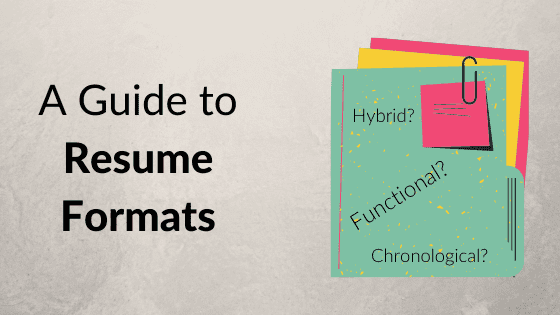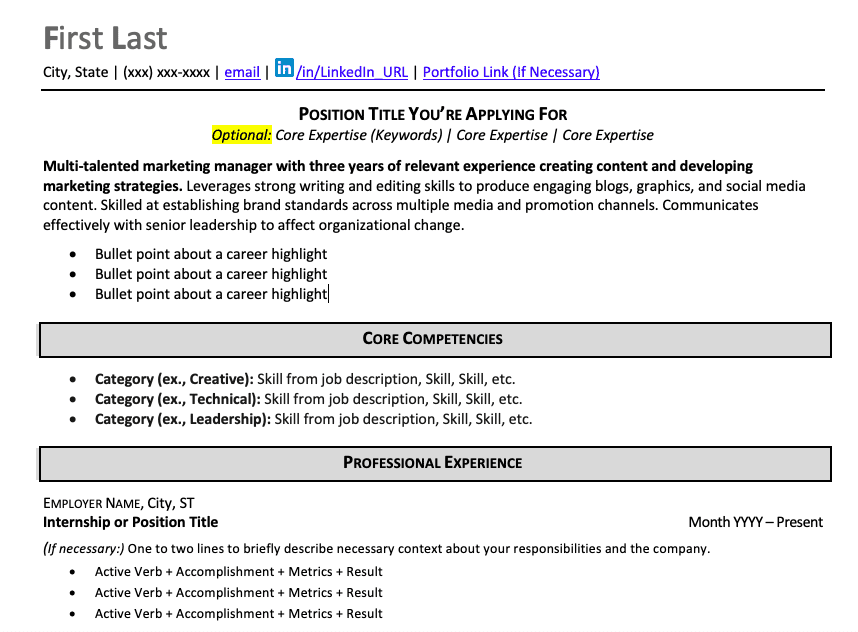“Chronologicals, Functionals, and Hybrids, Oh My!” Which Type of Resume Format Should You Use?

Chronological? Functional? What do they mean? Learn about the different types of resume formats and which one you should use — it’s simpler than you’d think.
By: Grace Mitchell | Contributor for Let’s Eat, Grandma
Confused about the different types of resumes? Did you just learn that there are different types of resumes, and now you’re consumed with existential dread? No need to fear! We’ve got you.
There are 3 main types of resume formats, but the distinctions can be difficult to understand. This blog will clarify the different types, along with defining a fourth option that we sometimes use, and explain when and why you might want to use each.
Ready for more job search help?
Sign up for a free Senior Writer Resume Critique to see what's holding you back from landing interviews. One of our top professional resume writers will give you personalized feedback on the top 3 items you can improve based on our expert practices!
The Three Main Types of Resume Formats
1) Chronological
When to Use: The chronological resume applies to most situations. In fact, you’re probably already using this type without realizing it!
A chronological resume lists experience in chronological (technically, reverse-chronological) order, beginning with the most recent job and descending into earlier jobs. It’s the most common format, and it’s the safest. Your jobs should always go in chronological order when possible. This format is best for Applicant Tracking Systems (ATS) and for recruiters because it’s what they’re used to and therefore easiest to read quickly.
2) Functional
When to Use: Please don’t.
A functional resume is a resume layout that primarily lists core skills with bullet points elaborating on them, while your work history is listed briefly below with little to no description.
In theory, this format emphasizes your skills and de-emphasizes the details of the positions you’ve held. So, people with career gaps may be tempted toward this style because it draws attention away from those gaps.
It also allows for people to cut right to the skills that are relevant for their new career, even if their more recent jobs didn’t feature these skills. However, most recruiters know this trick and therefore view this type of resume as trying to hide something.
Recruiters want to see the context of your experience. They’re looking for a person with a story to tell, not just a set of disjunct bullet points. Plus, they need to be able to scan your resume super quickly since they have dozens of others to go through, and an alternative format makes it harder for them to find what they need.
In short, functional resumes are not advisable. While writing a resume in this style may not be an automatic-reject, it’s not worth the risk. Besides, there are better ways to cover a career gap if you really need to.

3) Hybrid Resume Formats
When to Use: Since this type combines the practicality of the chronological resume with the benefits of the functional, it can be used any time you’d use a chronological resume!
A hybrid resume—also sometimes called a combination resume—lists bullets under the jobs in order like the chronological format, but lists skills before the chronological jobs. This way, you can still emphasize your skills before your work history while maintaining the readability that recruiters prefer.
While its structure differs slightly from that of a chronological resume, practically speaking a hybrid resume is largely the same as a chronological resume. In fact, there are dozens of ways you can create a resume that’s a “hybrid,” and it’s usually by putting your skills section first and using bullets in your summary. Just make sure you have all of the essential sections and order them in a way that makes sense for the job at hand.
But wait, there’s more!
An Additional Type: “Two-Tier” Resume Formats
When to Use: “Two-Tier” Resumes can be useful for those facing a career change or whose recent experience is less relevant to the job they’re applying for than past experience, though they do have potential drawbacks.
A special kind of hybrid resume, this format is less common but has worked for previous Let’s Eat, Grandma clients as an alternative to the functional resume.
A “two-tier” resume breaks your professional experience into two sections; the first is your experience that’s most relevant to the job at hand, while the second is all of your other positions. Jobs are chronological within each section, but may not be through the whole resume.
The pros: This resume type shows your most relevant experiences first, making it immediately clear why you’re qualified for the position.
The cons: As mentioned in the chronological section, it’s a little risky for Applicant Tracking Systems—try to get this format sent straight to a human if you can. There’s also a risk it can look like you’re trying to hide something, but if you nail it by showcasing your transferable skills in the first section, that risk decreases.
All-in-all, the chronological resume is a valuable go-to, but it’s not the only way to showcase your qualifications. Now that you have a better understanding of when to use each type, choose the format that works best for your unique situation and you can go back to writing worry-free.
Ready for more job search help?
Sign up for a free Senior Writer Resume Critique to see what's holding you back from landing interviews. One of our top professional resume writers will give you personalized feedback on the top 3 items you can improve based on our expert practices!
